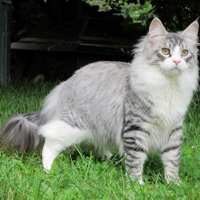|
A brief historical overview
|
The Maine Coon is probably one of North America's oldest natural breeds. Several legends describe the breed's origins. The most widespread is that the Maine coon is the result of a cross between cats and raccoons (colloquially coon, short for racoon), which would explain their color (the most common is brown tabby) and bushy tail. Of course, it's genetically impossible to produce such a hybrid, but the breed has kept its name from this legend.
The second is that the Maine Coon is a descendant of the six Angora cats sent by Marie-Antoinette of Austria as she prepared her escape from the French Revolution. These Angoras were brought on Captain Samuel Clough's ship Sally from Wiscasset, along with the Queen's other personal effects. The Angoras then mingled with local farm cats to give rise to the Maine coon.
Another theory is that the breed developed from crosses between local farm cats and other long- or semi-longhaired cats first imported by the Vikings around the year 1000. The Maine coon would then be descended from the Norwegian Forest Cat, which would explain their resemblance. This hypothesis is supported by the resemblance between the Van Turk, Siberians, Norwegians and finally Maine coons, whose geographical origins correspond to the movements of the Vikings. This resemblance to the Norwegian may also be explained by the fact that the winter climate of New England and Norway are identical, and would therefore have led to the selection of the same physical characteristics.
In the 19th century, Mrs. Pierce, one of the first Maine coon owners, also hypothesized that these cats had arrived on the Maine coast by sea, not thanks to the Vikings, but rather by wealthy Maine families who owned luxurious boats and traveled extensively. They would have brought back many exotic pets from their expeditions, especially for the amusement of their children. Mrs. Pierce's second hypothesis was that Angora cats were taken on board merchant ships to hunt rats. In either case, they would have landed on the East Coast and mingled with the local shorthair cats.
Another possibility is that they were imported by European immigrants and adapted to the region's harsh climate and living conditions. |
General appearance
|
The Maine Coon's body is long and rectangular, with a broad chest and powerful muscles. However, the overall silhouette must remain balanced and free from exaggeration. The Maine Coon is one of the largest cat breeds in the world. In 2006, the record for the world's longest cat (121.9 cm) was held by a maine coon named Leo. This record was beaten by another Maine coon named Stewie. The average cat weighs between 6 and 9 kg.
Males are more imposing (6 to 9 kg) than females (4 to 6 kg), roughly double the weight of alley cats. To reach such a weight, their growth is slow and lasts several years (between three and five). |
Behavior / characteristics
|
| Character traits are not described in the standards; they remain entirely individual and are a function of each cat's history. According to the LOOF portrait, the Maine coon gets along well with everyone, even strangers and other animals, and is gentle with children. It is attached to its family and other animals, including dogs. |
Health
|
As with any cat of a highly inbred breed, the Maine Coon can be affected by a number of diseases, the main one being Hypertrophic Cardiomyopathy (HCM).
In the Maine coon, this disease is transmitted in most cases in an autosomal dominant fashion, through a mutation in the MYBPC gene in the form HMC1, which is specific to the breed and has been the subject of a specific DNA test. The mobilization of Maine coon breeders against this disease and their collaboration with cardiology laboratories has enabled the implementation of this DNA test, whose short-term objective is to eradicate this form of cardiomyopathy specific to Maine coons, which accounts for 70% of known cases in the breed. It must be stressed, however, that this DNA test is not sufficient to confirm that a Maine coon is free of cardiomyopathy, and remains no more than a tool for the breeder: ultrasound monitoring with color Doppler and DTI remains absolutely essential in the monitoring of breeding stock.
Hip dysplasia can also affect Maine coons. This hereditary disease is characterized by malformation of the hip joints. Dyplasia causes painful damage to the joint, which can lead to osteoarthritis. There aren't many studies on the subject, but it seems that the breed is particularly affected - up to 20% according to the American Orthopedic Foundation for Animals. There is no treatment for this disease, apart from surgery to remove the malformed part of the femur. Medication may be administered to slow the damage to the cartilage or temporarily relieve inflammation.
The breed can also suffer from spinal muscular atrophy (SMA). This extremely rare disease in Maine coons causes degeneration of the neurons controlling the muscles. It is genetically transmitted in an autosomal recessive mode. Here too, a DNA screening test is available to detect mutations in the LIX1 gene responsible for the disease. |
Genetics
|
| Genetic research carried out by the University of California, Davis, has reported a very low frequency of the recessive allele responsible for Sacred Birman white gait in the Maine Coon. A specific genetic test exists to detect the Burmese gantage gene. |
|







 English (United Kingdom)
English (United Kingdom)